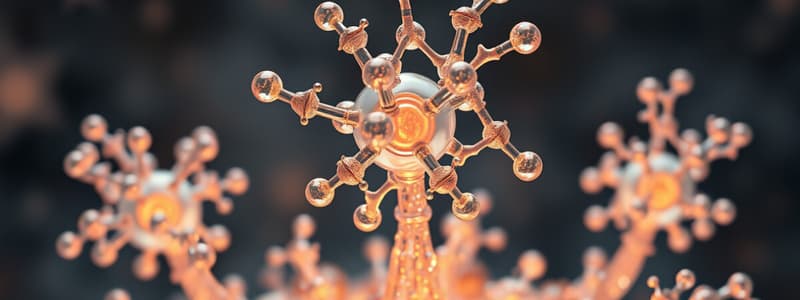Podcast
Questions and Answers
What are the characteristics of lipids?
What are the characteristics of lipids?
Generally hydrophobic, amphipathic, water-insoluble organic compounds, do not form large covalent polymers, associate through noncovalent forces, have a polar (hydrophilic) head and a nonpolar (hydrophobic) hydrocarbon tail.
Why are lipids hydrophobic?
Why are lipids hydrophobic?
A large portion of their structure is hydrocarbon.
What are the functions of lipids?
What are the functions of lipids?
Energy storage, signaling, formation of membrane structures.
What are the types of lipids?
What are the types of lipids?
What are membranes?
What are membranes?
What are the features of cellular membranes?
What are the features of cellular membranes?
Where can you find lipids in living organisms?
Where can you find lipids in living organisms?
What are the interactions that hold lipid molecules in water together?
What are the interactions that hold lipid molecules in water together?
How do lipids form membranes in aqueous solutions?
How do lipids form membranes in aqueous solutions?
What is the structure of fatty acid?
What is the structure of fatty acid?
What are the two types of fatty acids?
What are the two types of fatty acids?
What is saturated fatty acid?
What is saturated fatty acid?
What are the features of saturated fatty acids?
What are the features of saturated fatty acids?
What is unsaturated fatty acid?
What is unsaturated fatty acid?
Why are saturated fats solid at room temperature?
Why are saturated fats solid at room temperature?
Why are unsaturated fats liquid at room temperature?
Why are unsaturated fats liquid at room temperature?
What are the two orientations of double bonds in unsaturated fatty acids?
What are the two orientations of double bonds in unsaturated fatty acids?
What does the cis double bond do to the hydrocarbon chain?
What does the cis double bond do to the hydrocarbon chain?
Can the bonds in the hydrocarbon chain rotate?
Can the bonds in the hydrocarbon chain rotate?
Why do most naturally occurring fatty acids have an even number of carbon atoms?
Why do most naturally occurring fatty acids have an even number of carbon atoms?
What are the possible structures of the hydrocarbon chains?
What are the possible structures of the hydrocarbon chains?
What does the nomenclature of the fatty acid 20:4c^5,8,11,14 tell you?
What does the nomenclature of the fatty acid 20:4c^5,8,11,14 tell you?
How do nutritionists name fatty acids?
How do nutritionists name fatty acids?
What is w-3 fatty acid?
What is w-3 fatty acid?
What is the average pKa of fatty acids?
What is the average pKa of fatty acids?
Flashcards are hidden until you start studying
Study Notes
Characteristics of Lipids
- Generally hydrophobic or amphipathic; consist of water-insoluble organic compounds.
- Do not form large covalent polymers; associate through noncovalent forces.
- Composed of a polar (hydrophilic) head and a nonpolar (hydrophobic) hydrocarbon tail.
Hydrophobic Nature of Lipids
- The large hydrocarbon portion of lipids contributes to their hydrophobic properties.
Functions of Lipids
- Serve key roles in energy storage, cell signaling, and forming membrane structures.
Types of Lipids
- Lipids with fatty acids include: triacylglycerols, glycerophospholipids, waxes, and prostaglandins.
- Steroids are lipids that do not contain fatty acids.
Membranes
- Membranes partition cells into compartments and separate them from their surroundings.
Features of Cellular Membranes
- Exhibits selective permeability, creating compartmentalization.
- Allows for the storage of free energy in concentration gradients.
Location of Lipids in Organisms
- Typically not found free in solution; exist as complexes with protein transporters or in higher-order structures like micelles, vesicles, and bilayers.
Interactions in Lipid Aggregation
- Lipid molecules are held together in water primarily by noncovalent interactions.
- Hydrophobic effects help nonpolar tails interact, while van der Waals forces stabilize hydrocarbon regions.
Membrane Formation in Aqueous Solutions
- Polar, hydrophilic head groups of membrane lipids interact with water, leading to the formation of monolayers, bilayers, micelles, and vesicles.
Structure of Fatty Acids
- Composed of a hydrophilic carboxylate group and a hydrocarbon chain typically containing 12-24 carbons.
Types of Fatty Acids
- Saturated fatty acids: contain no double bonds.
- Unsaturated fatty acids: contain one or more double bonds.
Characteristics of Saturated Fatty Acids
- Composed entirely of single C-C bonds; fit closely together in a regular pattern.
- Exhibit strong intermolecular forces and high melting points (solid at room temperature).
Characteristics of Unsaturated Fatty Acids
- Contain one or more double bonds; typically liquid at room temperature.
- Example: Oleic acid.
Solid Nature of Saturated Fats
- Long, saturated chains pack closely due to strong van der Waals interactions, resulting in higher melting points.
Liquid Nature of Unsaturated Fats
- Presence of bends from cis double bonds prevents tight packing, contributing to a more dynamic structure.
Orientations of Double Bonds in Fatty Acids
- Unsaturated fatty acids may have cis or trans double bonds.
Impact of Cis Double Bonds
- Cis double bonds introduce a bend in the hydrocarbon chain.
Flexibility of Hydrocarbon Chains
- Single bonds within the hydrocarbon chain rotate freely.
Carbon Chain Evenness in Fatty Acids
- Most naturally occurring fatty acids have an even number of carbon atoms due to synthesis from two-carbon precursors.
Hydrocarbon Chain Structures
- Fatty acids usually have linear hydrocarbon chains, although some may exhibit branches or cyclic structures.
Fatty Acid Nomenclature Example
- 20:4c^5,8,11,14 specifies 20 carbons, 4 cis-double bonds at carbons 5, 8, 11, and 14.
Naming of Fatty Acids by Nutritionists
- Naming convention involves identifying the location of C=C bonds, referencing the 'omega' carbon (last C) and 'alpha' carbon (COO- carbon).
Omega-3 Fatty Acid
- Defined as having a double bond at the third carbon from the omega carbon.
Average pKa of Fatty Acids
- The average pKa is 4.5, indicating that fatty acids are weak acids, existing in an equilibrium between their protonated and deprotonated forms.
Studying That Suits You
Use AI to generate personalized quizzes and flashcards to suit your learning preferences.



